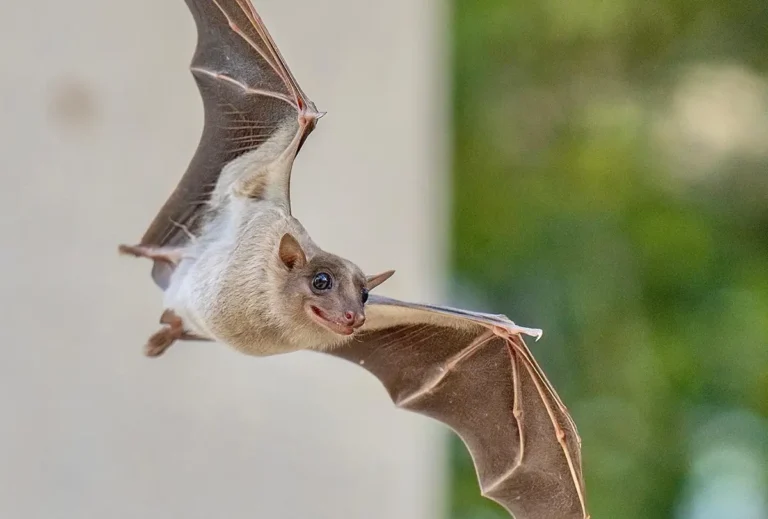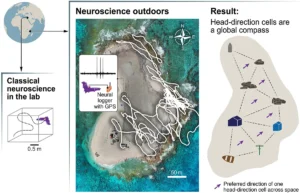How a Bat’s Brain Works: They Have GPS Cells
New research on wild bats reveals their brains build a stable, internal compass by memorizing visual landmarks, not by using magnetic fields.

Key Findings
- Scientists recorded a stable "global" neural compass in wild bats.
- This internal compass is learned over several nights and is not innate.
- The compass does not rely on the Earth's magnetic field or celestial cues like the moon and stars.
- Bats' brains anchor this compass to stable, visual landmarks on the ground, like cliffs and coastlines.
Primary Source
Source: Out of the lab and into nature: Going to the ends of the Earth to better understand the brain
Author(s): Prof. Nachum Ulanovsky's lab at the Weizmann Institute of Science
How Does a Bat’s Brain Build an Internal Compass?
How do you find your way? You probably pull out your phone and open a map. But what if you had no phone and no map? You would likely look for landmarks. You might use a tall building, a bridge, or a unique hill to get your bearings. This is called navigation. For decades, scientists have wondered how animals do it, especially over huge distances. Do they use a “sixth sense” like the Earth’s magnetic field? Or are they more like us than we think? New research on wild bats gives us a clear answer1Weizmann Institute of Science. (2025, October 16). Out of the lab and into nature: Going to the ends of the Earth to better understand the brain. Weizmann Wander. Accessed October 19, 2025, https://wis-wander.weizmann.ac.il/life-sciences/out-lab-and-nature-going-ends-earth-better-understand-brain. It turns out they are a lot like us.
Scientists have discovered that a bat’s brain builds a stable, internal “global compass”. This compass does not use magnetic fields or the stars. Instead, it works by memorizing the stable, visual landmarks of the bat’s environment, just like you would. This finding comes from a groundbreaking new field called “Natural Neuroscience,” which takes the laboratory directly into the wild. (While focused on navigation, these findings were part of a broader study also examining bat social behavior, published in the journal Science2Ray S., Yona I., Elami N., Palgi S., et al., Ulanovsky N. (2025). Hippocampal coding of identity, sex, hierarchy, and affiliation in a social group of wild fruit bats. Science, 387(6733), eadk9385. Accessed October 19, 2025, https://doi.org/10.1126/science.adk9385).

This diagram illustrates the progression from classical lab research (left) to “Neuroscience outdoors” on Latham Island (center). The result (right) shows head-direction cells firing in a consistent direction across the entire space, acting as a global compass anchored to landmarks. Image credit: Weizmann Institute of Science.
How Did Scientists Record a Bat’s Brain in the Wild?
This experiment was an enormous challenge3Diving in with Nachum Ulanovsky | The Transmitter: Neuroscience News and Perspectives. Accessed October 19, 2025, https://www.thetransmitter.org/neuroethology/diving-in-with-nachum-ulanovsky/. Studying animal brains in a lab is one thing. You have a controlled, safe space. But studying a wild animal’s brain while it flies freely is something else entirely. The team, led by Professor Nachum Ulanovsky, had to find the perfect “natural laboratory”.
They found it on Latham Island, a remote, uninhabited island off the coast of Tanzania. The island was big enough for bats to fly naturally. It was also small and isolated enough that the bats would not leave, so the team could recapture them.
To record the brain activity, the team used a tiny, custom-built device called a “Neurologger”4Brain research goes wild – Weizmann Institute of Science. Accessed October 19, 2025, https://www.weizmann.ac.il/WeizmannCompass/sections/features/brain-research-goes-wild. This device is a high-tech backpack for a bat. It weighs very little and combines a GPS tracker with tiny electrodes that can record signals from individual brain cells. For 30-50 minutes each night, the bats flew freely around the island while the Neurologger recorded their flight paths and their brain signals at the exact same time.
What Did the Bat Brains Reveal?
The researchers were looking at a specific type of brain cell called a “head-direction cell”. You can think of these cells as the brain’s own compass needles. A specific cell will fire only when the bat’s head is pointing, for example, to the north. Another cell fires when the bat points east, and so on.
The first major discovery was that this compass was “global”. This means a “north” cell fired when the bat faced north, no matter where it was on the island. Whether it was on the western coast or the southern coast, “north” was always “north”. This proved the bats have a single, unified compass for their entire territory.
Was This Compass Innate or Was It Learned?
This was the biggest question. Many scientists believed animals used an innate, or “built-in,” sense. This might be a sense of the Earth’s magnetic field (called magnetoreception). If that were true, the bat’s compass should work perfectly from the first moment.
But that is not what the data showed. During the bats’ first few nights on the island, their internal compass was unstable. The “north” cells were not firing consistently in the same direction. The bats were, in effect, lost. Their brains had not yet built a map.
However, after a “gradual learning process” over several nights of flight, the compass signal suddenly locked in. It became perfectly stable and stayed that way. This is powerful proof. It shows the bat’s compass is not innate. It must be learned by exploring a new environment.
So, What Is the Compass ‘Anchored’ To?
If the compass is not magnetic, what is the anchor? The team tested two other ideas. First, they checked celestial cues, like the moon and stars. They compared bat flights on clear nights to flights on cloudy nights. The compass worked perfectly on both. The bats did not need to see the sky.
The evidence pointed to one clear conclusion. The bats were anchoring their internal compass to the stable, visual landmarks of the island itself. Through exploration, their brains learned the spatial relationships between prominent features like cliffs, coastlines, and large boulders. They were building a cognitive map founded on the visual topography of their environment, just as an ancient sailor would navigate by the coastline.
Why Does a Bat’s Brain Matter to Me?
This discovery is exciting because your brain has the exact same navigation system. You have place cells5O’Keefe, J., & Dostrovsky, J. (1971). The hippocampus as a spatial map: preliminary evidence from unit activity in the freely-moving rat. Brain Research, 34(1), 171-175. Accessed October 19, 2025, https://doi.org/10.1016/0006-8993(71)90358-1, grid cells6Hafting, T., Fyhn, M., Molden, S., Moser, M. B., & Moser, E. I. (2005). Microstructure of a spatial map in the entorhinal cortex. Nature, 436(7052), 801-806. Accessed October 19, 2025, https://doi.org/10.1038/nature03721, and head-direction cells, all working together in a region called the hippocampus. This system is what builds your own internal maps and lets you navigate your world.
Sadly, this is also one of the very first brain regions attacked by Alzheimer’s disease. This is why one of the earliest and most heartbreaking symptoms is spatial disorientation, or getting lost in familiar places7Scientists just found the brain’s secret GPS system | ScienceDaily. Accessed October 19, 2025, https://www.sciencedaily.com/releases/2025/08/250820000757.htm. This new research suggests what might be going wrong. It may not just be “memory loss.” It could be a failure of this specific “anchoring” process. The brain’s map becomes “unmoored” from the world’s visual landmarks, leading to confusion.
By understanding how a healthy brain learns to anchor its map, we may one day develop new tools to detect Alzheimer’s much earlier. We could test this anchoring ability long before other cognitive decline appears.
What Questions Are Scientists Asking Next?
This study is a huge victory for “Natural Neuroscience”. It proves we can now study the brain as it performs complex, natural behaviors in the real world. But it also opens up new questions. How does this system work in a complex forest, full of moving trees? How do bats navigate together as a group?
The answers could also help build better technology. This research provides a biological blueprint for autonomous drones and robots8Neuroscientists Reveal ‘Neural Compass’ That Stops You From Getting Lost – Newsweek. Accessed October 19, 2025, https://www.newsweek.com/neuroscientists-reveal-neural-compass-stops-lost-navigation-1897209. It shows how a machine could learn to navigate new, complex environments by building its own visual maps, all without needing GPS.
